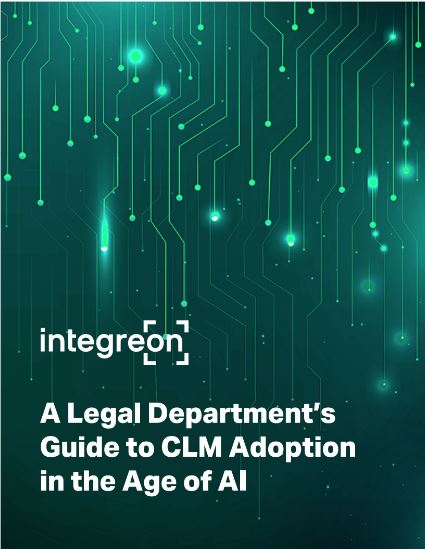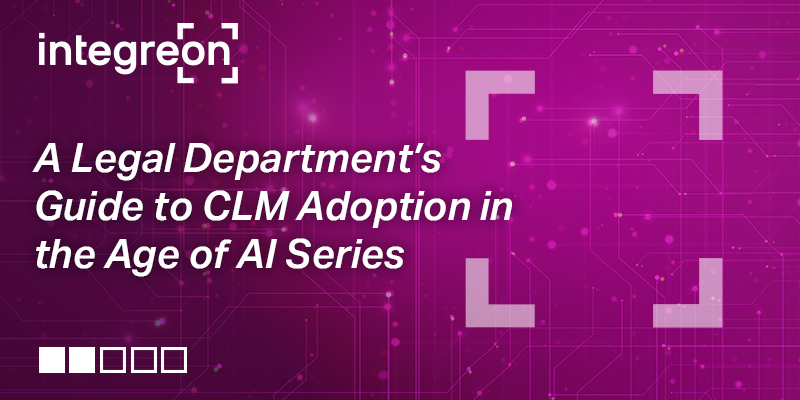This is the second blog of a five-part series on CLM Adoption in the Age of AI. Read the first blog here.
Before you begin the process of evaluating genAI-enabled CLM systems it is important to fully understand your own environment. This includes conducting an internal assessment of your own AI and contracts process maturity. The goal isn’t to choose the “best” or most advanced CLM tool on the market, it’s to choose the solution and vendor that best addresses your specific challenges, integrates easily with your environment, and shares a similar appetite for innovation.
Here are five steps to take to prepare internally before you evaluate CLM systems.
1. Map out your workflow and processes
Documenting current contract management processes will give you a better understanding of how the CLM solution will function within your existing environment. Where are the inefficiencies? Are there opportunities to streamline or automate steps? For example, if you have bottlenecks in approval workflows, prioritize solutions with advanced automation or escalation capabilities. Also, consider your metrics and what you are currently and should be measuring.
2. Get your data house in order
AI is only as powerful as the data it is built on. Without robust, organized, and comprehensive data inputs, you’ll be limited in what you can achieve. For the vast majority of organizations, data is often duplicated, incomplete, and lacking meaningful reference tags or taxonomies to support search. Having AI-ready data is the only way to drive a real return on investment (ROI) from any tool or process you implement. Putting in the effort or engaging services to organize your contract repository and ensure data accuracy will set you up for success as you continue your legal digital transformation journey.
3. Assess your AI readiness
In addition to data readiness, there are other factors that contribute to genAI adoption readiness. Not all businesses have the same level of AI maturity. Important considerations include whether you have the right human resources available or the ability to train employees to maintain and enhance your AI tools over time.
Solutions come in varying forms of complexity, and taking on more than you can handle won’t get you the results you need. Lacking resources to fully “own” and maintain the AI tools doesn’t mean that you need to postpone adoption of gen AI. Just be sure to invest in services from your vendor or another trusted third-party who can train and update the AI for you until you decide if in-house resource expertise and ownership is feasible or even required.
Additionally, different organizations have different cultures when approaching AI adoption. For example, do the lawyers on your team require AI with “explainability” for its outputs, or is the team comfortable with more of a black box solution? Does the team need the AI to be fine-tuned to make redline edits or are clause location and analysis tools sufficient? Organizations that are truly ready to adopt AI have also considered any workforce impacts to adopting CLM tools. It is key to understand the roles that people play in the current contracts workflow and be prepared to address any training, upskilling or other impacts of AI adoption.
4. Define specific use cases
Another best practice step to take before making your CLM technology purchase is to identify clear and specific target use cases. You have to know which tasks you want the tool to perform.
Examples include:
- Contract creation: Develop first drafts with AI-suggested content based on a library of relevant topics and clauses.
- Redline review and contract clause analysis: Perform reviews based on playbook options and preferred or historical positions.
- Bulk extraction: identify key content for repository search tagging, risk analysis, or compliance actions.
Technology adoption should flow from your specific needs. Instead of getting distracted by shiny tools or market trends, focus on identifying use cases grounded in your organization and department’s requirements.
The best use cases have clear goals. Whether you’re looking to streamline contract review or automate aspects of data management, every use case should come from understanding your defined business objectives.
5. Anticipate your reporting needs
Reporting is a critical element of any CLM solution. Therefore, it’s essential to understand what information matters most to your department and satisfies broader organizational interests.
Consider which insights are most critical, such as basic workflow metrics like volumes, turnaround times (TAT), approval and escalation counts, etc. Or, your team may require advanced content analysis, such as most negotiated terms, frequency of deviations from standard agreements, the ability to classify risks, etc.
Be sure you understand what data points your selected CLM tool captures, what is surfaced by out-of-the-box reports, and what can be exported to more sophisticated data visualization tools like MS Power BI, that you might be able to leverage from your broader IT environment.
Lastly, determine if you need to understand legacy portfolio of agreements, or if the focus should be solely on current and future contracts. By anticipating your reporting requirements, you will be better positioned to choose a CLM tool that delivers meaningful insights.
This is the second blog of a five-part series on CLM Adoption in the Age of AI. Read the first blog here.
If you are interested in learning more about how you can effectively evaluate, adopt, and optimize CLM technology in 2025, especially given the new dimension genAI creates for this class of legal tech, then download our eBook, “A Legal Department’s Guide to CLM Adoption in the Age of AI.”
In this guide, we aim to provide some new parameters for how businesses evaluate, adopt, and optimize their CLM tools, especially given the expanded use of generative AI. From the latest advancements to practical implementation strategies, we will share insights to help you make the best decisions when it comes to your CLM technology strategy today – and unlock the power of your legal data. Download it today.

This 8-page guide covers:
- Understanding Generative AI (genAI) in CLM Solutions
- Internal Considerations for CLM Technology
- CLM Vendor Selection Considerations
- Getting the Most Out of your CLM Solution
- Gaining Momentum: Tech as a Service


